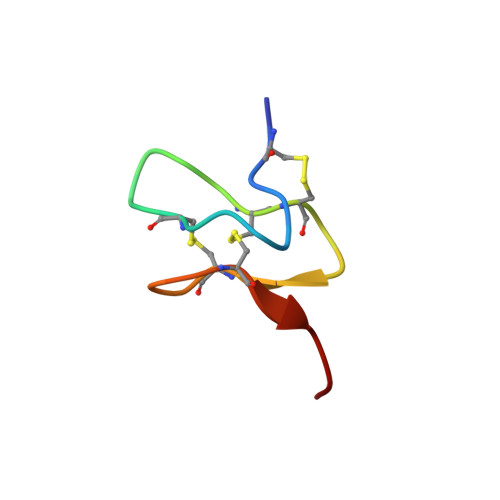Peptide-Membrane Interactions Affect the Inhibitory Potency and Selectivity of Spider Toxins ProTx-II and GpTx-1.
Lawrence, N., Wu, B., Ligutti, J., Cheneval, O., Agwa, A.J., Benfield, A.H., Biswas, K., Craik, D.J., Miranda, L.P., Henriques, S.T., Schroeder, C.I.(2019) ACS Chem Biol 14: 118-130
- PubMed: 30507158
- DOI: https://doi.org/10.1021/acschembio.8b00989
- Primary Citation of Related Structures:
6MK4, 6MK5 - PubMed Abstract:
Gating modifier toxins (GMTs) from spider venom can inhibit voltage gated sodium channels (Na V s) involved in pain signal transmission, including the Na V 1.7 subtype. GMTs have a conserved amphipathic structure that allow them to interact with membranes and also with charged residues in regions of Na V that are exposed at the cell surface. ProTx-II and GpTx-1 are GMTs able to inhibit Na V 1.7 with high potency, but they differ in their ability to bind to membranes and in their selectivity over other Na V subtypes. To explore these differences and gain detailed information on their membrane-binding ability and how this relates to potency and selectivity, we examined previously described Na V 1.7 potent/selective GpTx-1 analogues and new ProTx-II analogues designed to reduce membrane binding and improve selectivity for Na V 1.7. Our studies reveal that the number and type of hydrophobic residues as well as how they are presented at the surface determine the affinity of ProTx-II and GpTx-1 for membranes and that altering these residues can have dramatic effects on Na V inhibitory activity. We demonstrate that strong peptide-membrane interactions are not essential for inhibiting Na V 1.7 and propose that hydrophobic interactions instead play an important role in positioning the GMT at the membrane surface proximal to exposed Na V residues, thereby affecting peptide-channel interactions. Our detailed structure-activity relationship study highlights the challenges of designing GMT-based molecules that simultaneously achieve high potency and selectivity for Na V 1.7, as single mutations can induce local changes in GMT structure that can have a major impact on Na V -inhibitory activity.
- Institute for Molecular Bioscience , The University of Queensland , Brisbane , Queensland 4072 , Australia.
Organizational Affiliation:
















